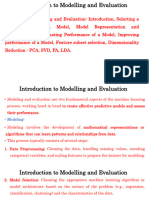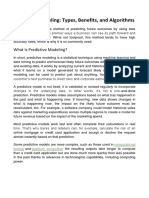0 ratings0% found this document useful (0 votes)
2 viewsCommon Issues in Machine Learning
The document discusses common issues faced in machine learning, including inadequate and poor quality training data, overfitting and underfitting, and the need for regular monitoring and maintenance of models. It highlights the importance of using representative data, addressing data bias, and the shortage of skilled professionals in the field. Additionally, it emphasizes the complexity of the ML process and the significance of accurate customer segmentation for effective algorithms.
Uploaded by
shalini gambhirCopyright
© © All Rights Reserved
Available Formats
Download as PDF, TXT or read online on Scribd
0 ratings0% found this document useful (0 votes)
2 viewsCommon Issues in Machine Learning
The document discusses common issues faced in machine learning, including inadequate and poor quality training data, overfitting and underfitting, and the need for regular monitoring and maintenance of models. It highlights the importance of using representative data, addressing data bias, and the shortage of skilled professionals in the field. Additionally, it emphasizes the complexity of the ML process and the significance of accurate customer segmentation for effective algorithms.
Uploaded by
shalini gambhirCopyright
© © All Rights Reserved
Available Formats
Download as PDF, TXT or read online on Scribd
You are on page 1/ 12
Common Issues in Machine Learning
Dr. Shalini Gambhir
Dr. Shalini Gambhir
Common Issues in Machine Learning
• Machine Learning (ML) has undoubtedly transformed
industries by enabling data-driven decision-making.
However, it's crucial to acknowledge the practical
challenges that professionals face while honing ML skills
and developing applications from scratch.
Dr. Shalini Gambhir
1. Inadequate Training Data
• The backbone of any ML algorithm is the data it is
trained on. The challenge arises when there is a
shortage of both quality and quantity in the training
dataset. Noisy, incorrect, or unclean data can
significantly impact the effectiveness of ML algorithms.
Addressing issues such as noisy data, inaccuracies, and
difficulties in generalizing output data becomes
paramount for accurate predictions.
Dr. Shalini Gambhir
2. Poor Quality of Data
• Data quality is a recurring issue, with noisy, incomplete,
and inaccurate data undermining the accuracy of
classification and overall results. Achieving high-quality
data is essential for the success of ML models,
necessitating a meticulous approach to data
preparation.
Dr. Shalini Gambhir
3. Non-representative Training
Data
• The representativeness of training data directly
influences the generalization capability of ML models. If
training data fails to cover all relevant cases, the model
may produce less accurate predictions, leading to bias
against specific classes or groups. Using representative
data in training mitigates biases and enhances
prediction accuracy.
Dr. Shalini Gambhir
4. Overfitting and Underfitting
• Overfitting occurs when a model captures noise and
inaccuracies from a large dataset, adversely affecting
its performance. This can be mitigated by employing
linear and parametric algorithms, increasing training
data, or reducing model complexity. Conversely,
underfitting arises from a model being too simple for
the data, resulting in incomplete and inaccurate
predictions. Methods to address underfitting include
increasing model complexity, using better features, and
adjusting constraints.
Dr. Shalini Gambhir
5. Monitoring and Maintenance
• Regular monitoring and maintenance are essential to
ensure the continued effectiveness of ML models.
Changes in data or user expectations may necessitate
code adjustments and resource updates, emphasizing
the need for ongoing vigilance.
Dr. Shalini Gambhir
6. Getting Bad
Recommendations
• ML models operating in a specific context may provide
outdated or irrelevant recommendations, known as data
drift. Regularly updating and monitoring data helps
mitigate this issue, ensuring recommendations align
with current user expectations.
Dr. Shalini Gambhir
7. Lack of Skilled Resources
• The shortage of skilled professionals with in-depth
knowledge of mathematics, science, and technology
poses a challenge in the ML industry. Addressing this
gap requires investing in training and education to
cultivate a workforce equipped to handle the intricacies
of ML.
Dr. Shalini Gambhir
8. Customer Segmentation
• Accurate customer segmentation is crucial for effective
ML algorithms. Developing algorithms that recognize
customer behavior and trigger relevant
recommendations based on past experiences is
essential for personalized user interactions.
Dr. Shalini Gambhir
9. Process Complexity of
Machine Learning
• The complexity of the ML process, marked by
experimental phases and continuous changes, presents
a challenge for engineers and data scientists. The
evolving nature of ML and the multitude of experiments
contribute to a higher probability of errors, making the
process intricate and demanding.
Dr. Shalini Gambhir
10. Data Bias
• Data bias introduces errors when certain elements in
the dataset are given disproportionate weight.
Detecting and mitigating bias requires careful
examination of the dataset, regular analysis, and
implementing strategies to ensure data diversity.
Dr. Shalini Gambhir
You might also like
- Odoo 17 Development Tutorials - CybrosysNo ratings yetOdoo 17 Development Tutorials - Cybrosys5 pages
- Issues in Machine Learning With Conclution (2)No ratings yetIssues in Machine Learning With Conclution (2)8 pages
- Issues in Machine Learning With ConclutionNo ratings yetIssues in Machine Learning With Conclution9 pages
- One more way to categorize Machine Learning systems is by how they generalizeNo ratings yetOne more way to categorize Machine Learning systems is by how they generalize2 pages
- 1.3 Impact of Applying Data Science in Business ScenarioNo ratings yet1.3 Impact of Applying Data Science in Business Scenario17 pages
- (DS@UIT Seminar) How To Avoid Machine Learning Pitfalls A Guide For Academic ResearchersNo ratings yet(DS@UIT Seminar) How To Avoid Machine Learning Pitfalls A Guide For Academic Researchers27 pages
- Harnessing The Power of Machine LearningNo ratings yetHarnessing The Power of Machine Learning11 pages
- 7 Machine Learning and Deep Learning Mistakes and Limitations To AvoidNo ratings yet7 Machine Learning and Deep Learning Mistakes and Limitations To Avoid10 pages
- Underfitting and Overfitting Slides and TranscriptNo ratings yetUnderfitting and Overfitting Slides and Transcript13 pages
- Towards Trustworthy Machine Learning in HealthcareNo ratings yetTowards Trustworthy Machine Learning in Healthcare9 pages
- Predictive Modeling: Types, Benefits, and AlgorithmsNo ratings yetPredictive Modeling: Types, Benefits, and Algorithms4 pages
- Model Monitoring With Grafana and Dynatrace: A Comprehensive Framework For Ensuring ML Model PerformanceNo ratings yetModel Monitoring With Grafana and Dynatrace: A Comprehensive Framework For Ensuring ML Model Performance10 pages
- Introduction To Gender and Age Detection ProjectNo ratings yetIntroduction To Gender and Age Detection Project8 pages
- Slidesgo Exploring Loss Functions and Surrogate Approaches in Deep Learning Challenges in Neural Network Opt 20250102153205ENKzNo ratings yetSlidesgo Exploring Loss Functions and Surrogate Approaches in Deep Learning Challenges in Neural Network Opt 20250102153205ENKz14 pages
- Note - Before Use Check Answers According To Your Syllabus.: ImportanceNo ratings yetNote - Before Use Check Answers According To Your Syllabus.: Importance31 pages
- 2020-Maleki-(NeuroimageClin)-Machine Learning Algorithm Validation ...No ratings yet2020-Maleki-(NeuroimageClin)-Machine Learning Algorithm Validation ...13 pages
- 50 AI Engineer Interview Questions & Answers [2025] - DigitalDefyndNo ratings yet50 AI Engineer Interview Questions & Answers [2025] - DigitalDefynd27 pages
- Overfitting and Underfitting in Machine LearningNo ratings yetOverfitting and Underfitting in Machine Learning3 pages
- Lecture 4 Sensitivity-374225-16754388280675No ratings yetLecture 4 Sensitivity-374225-1675438828067554 pages
- CYCLE-1: Experiment 3 Steady-State Performance of 3-Phase TransformerNo ratings yetCYCLE-1: Experiment 3 Steady-State Performance of 3-Phase Transformer5 pages
- Infinity Hardware Resource Allocation GuideNo ratings yetInfinity Hardware Resource Allocation Guide10 pages
- Sample Answer: Can Systematically Develop An Argument Giving The Reasons For or Against A Point of ViewNo ratings yetSample Answer: Can Systematically Develop An Argument Giving The Reasons For or Against A Point of View3 pages
- Google Chrome: Language Download PDF Watch EditNo ratings yetGoogle Chrome: Language Download PDF Watch Edit22 pages
- The Use of Sleepers Made of FFU Synthetic Wood in EuropeNo ratings yetThe Use of Sleepers Made of FFU Synthetic Wood in Europe5 pages
- Auto Body Repair Technology: Ch. 15,16 Key TermsNo ratings yetAuto Body Repair Technology: Ch. 15,16 Key Terms1 page
- Final Year Project Proposal E-Leather PDFNo ratings yetFinal Year Project Proposal E-Leather PDF7 pages
- Dsce-course Registration Form_6th Sem._2024-25[1]No ratings yetDsce-course Registration Form_6th Sem._2024-25[1]1 page
- Chapter 1 Effects Online Games AddictionNo ratings yetChapter 1 Effects Online Games Addiction5 pages
- One more way to categorize Machine Learning systems is by how they generalizeOne more way to categorize Machine Learning systems is by how they generalize
- 1.3 Impact of Applying Data Science in Business Scenario1.3 Impact of Applying Data Science in Business Scenario
- (DS@UIT Seminar) How To Avoid Machine Learning Pitfalls A Guide For Academic Researchers(DS@UIT Seminar) How To Avoid Machine Learning Pitfalls A Guide For Academic Researchers
- 7 Machine Learning and Deep Learning Mistakes and Limitations To Avoid7 Machine Learning and Deep Learning Mistakes and Limitations To Avoid
- Underfitting and Overfitting Slides and TranscriptUnderfitting and Overfitting Slides and Transcript
- Towards Trustworthy Machine Learning in HealthcareTowards Trustworthy Machine Learning in Healthcare
- Predictive Modeling: Types, Benefits, and AlgorithmsPredictive Modeling: Types, Benefits, and Algorithms
- Model Monitoring With Grafana and Dynatrace: A Comprehensive Framework For Ensuring ML Model PerformanceModel Monitoring With Grafana and Dynatrace: A Comprehensive Framework For Ensuring ML Model Performance
- Slidesgo Exploring Loss Functions and Surrogate Approaches in Deep Learning Challenges in Neural Network Opt 20250102153205ENKzSlidesgo Exploring Loss Functions and Surrogate Approaches in Deep Learning Challenges in Neural Network Opt 20250102153205ENKz
- Note - Before Use Check Answers According To Your Syllabus.: ImportanceNote - Before Use Check Answers According To Your Syllabus.: Importance
- 2020-Maleki-(NeuroimageClin)-Machine Learning Algorithm Validation ...2020-Maleki-(NeuroimageClin)-Machine Learning Algorithm Validation ...
- 50 AI Engineer Interview Questions & Answers [2025] - DigitalDefynd50 AI Engineer Interview Questions & Answers [2025] - DigitalDefynd
- Mastering Machine Learning: A Comprehensive Guide to SuccessFrom EverandMastering Machine Learning: A Comprehensive Guide to Success
- CYCLE-1: Experiment 3 Steady-State Performance of 3-Phase TransformerCYCLE-1: Experiment 3 Steady-State Performance of 3-Phase Transformer
- Sample Answer: Can Systematically Develop An Argument Giving The Reasons For or Against A Point of ViewSample Answer: Can Systematically Develop An Argument Giving The Reasons For or Against A Point of View
- The Use of Sleepers Made of FFU Synthetic Wood in EuropeThe Use of Sleepers Made of FFU Synthetic Wood in Europe
























































































